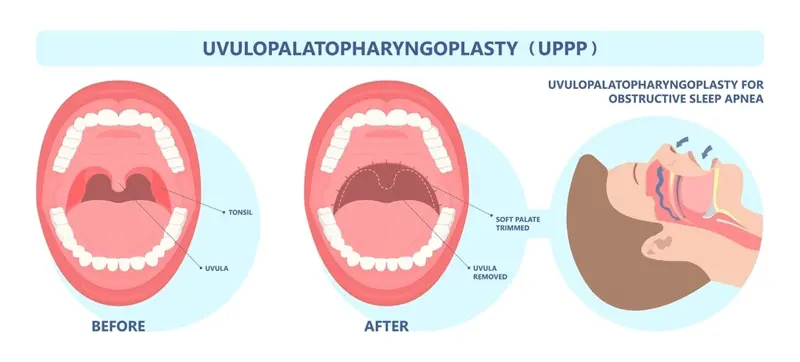Exploring Surgical Options for Effective Snoring Treatment
May 18th 2023
Introduction to Snoring Surgery
Snoring surgery is often considered when non-invasive treatments have proven unsuccessful. Surgical interventions for snoring aim to improve airflow and reduce tissue vibration in the upper airway, ultimately minimizing or eliminating snoring. This article will discuss various surgical options for snoring, their success rates, and long-term outcomes. Learn more about snoring surgery from the Mayo Clinic.
Uvulopalatopharyngoplasty (UPPP)

Uvulopalatopharyngoplasty (UPPP) is a surgical procedure that involves removing excess tissue from the throat to widen the airway and reduce snoring. The surgery typically targets the uvula, soft palate, and sometimes the tonsils. UPPP has shown moderate success in treating snoring, but it can be invasive and may require a lengthy recovery time. Find out more about UPPP on WebMD.
Pillar Procedure
The Pillar Procedure is a minimally invasive surgery that involves implanting small, polyester rods into the soft palate. These implants stiffen the soft palate, reducing vibration and snoring. The procedure can be performed under local anesthesia; recovery time is typically short. Discover more about the Pillar Procedure from the Sleep Foundation.
Laser-Assisted Uvulopalatoplasty (LAUP)
Laser-Assisted Uvulopalatoplasty (LAUP) uses a laser to remove a portion of the uvula and reshape the soft palate to alleviate snoring. The procedure is less invasive than UPPP and can be performed under local anesthesia. However, it may not be as effective in treating severe snoring. Learn more about LAUP on Healthline.
Radiofrequency Ablation (RFA)
Radiofrequency Ablation (RFA) involves using radiofrequency energy to shrink and tighten tissues in the throat, reducing snoring. This minimally invasive procedure is typically performed in an outpatient setting under local anesthesia. RFA has shown promising results in reducing snoring, but its long-term effectiveness is still under investigation. Explore RFA treatment on Medical News Today.
Septoplasty and Turbinate Reduction

Septoplasty is a surgery that corrects a deviated septum, which can sometimes contribute to snoring. Turbinate Reduction is a procedure that aims to reduce the size of the nasal turbinates to improve airflow and decrease snoring. Both surgeries can effectively treat snoring when nasal obstruction is the primary cause. Read more about Septoplasty on Harvard Health Blog.
Genioglossus Advancement (GA) and Hyoid Suspension
Genioglossus Advancement (GA) is a surgery that repositions the tongue to prevent it from blocking the airway during sleep, reducing snoring. This procedure is often combined with other surgeries, such as UPPP, to maximize effectiveness. Learn more about GA from the National Institutes of Health.
Hyoid Suspension is a procedure that repositions the hyoid bone to stabilize the airway and decrease snoring. This surgery is typically considered for patients with severe snoring or sleep apnea who have not found relief through other treatments. Discover more about Hyoid Suspension on Verywell Health.
Candidate Evaluation and Pre-Surgery Assessments
Healthcare professionals will determine whether a patient is suitable for snoring surgery through thorough evaluations and pre-surgery assessments. These assessments often include sleep studies, physical examinations, and consultations with sleep specialists. The most appropriate surgical option depends on the patient's specific anatomy and the severity of their snoring.
Risks and Complications
All surgical procedures carry risks and complications. These may include infection, bleeding, pain, and anesthesia complications. It is crucial to discuss these factors with your healthcare professional to make an informed decision about whether snoring surgery is right for you.
Post-Operative Care and Recovery
The recovery process after snoring surgery varies depending on the procedure. Pain management, wound care, and follow-up appointments are essential for post-operative care. Following your healthcare professional's instructions ensures a smooth recovery and the best possible outcomes.
Surgery Success Rates and Long-Term Outcomes
Success rates for snoring surgery options vary, but many patients experience significant improvement in their snoring symptoms. Long-term effectiveness depends on factors such as the patient's overall health, lifestyle choices, and adherence to post-operative care instructions.
Frequently Asked Questions
- Is snoring surgery painful? Some discomfort and pain are expected following snoring surgery, but this can typically be managed with pain medications prescribed by your healthcare provider.
- How long does it take to recover from snoring surgery? Recovery time varies depending on the procedure, but most patients can return to normal activities within one to three weeks following surgery.
- Will snoring surgery cure sleep apnea? While snoring surgery can help reduce sleep apnea symptoms in some cases, it is not a guaranteed cure. It's essential to discuss your specific situation with your healthcare provider.
- Is snoring surgery covered by insurance? Insurance coverage for snoring surgery varies depending on the specific procedure and your insurance plan. Consult with your insurance provider to determine coverage.
- Are there any alternatives to snoring surgery? There are various non-surgical treatment options for snoring, including lifestyle changes, positional therapy, and oral appliances. Surgery is typically considered when these treatments have been unsuccessful.
